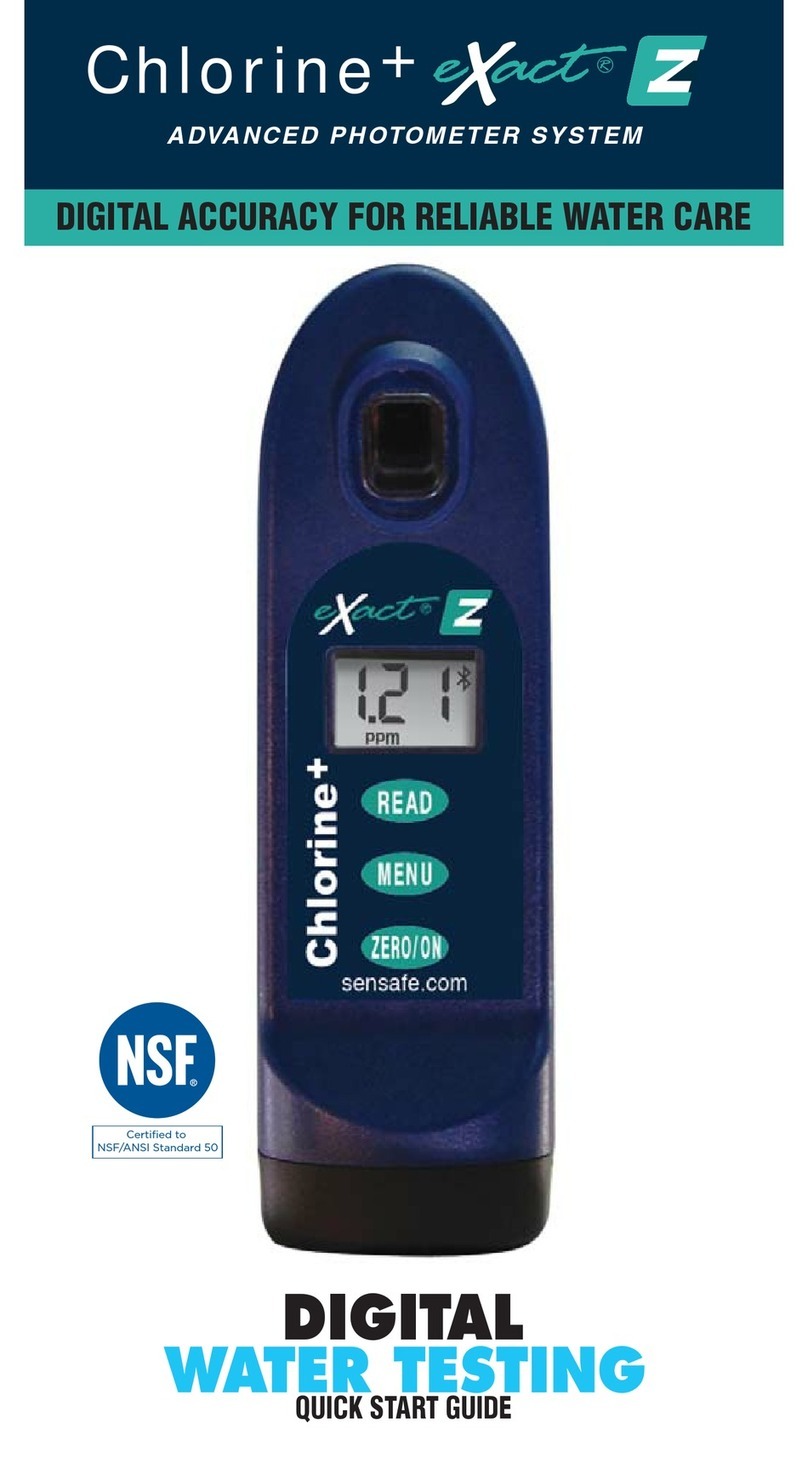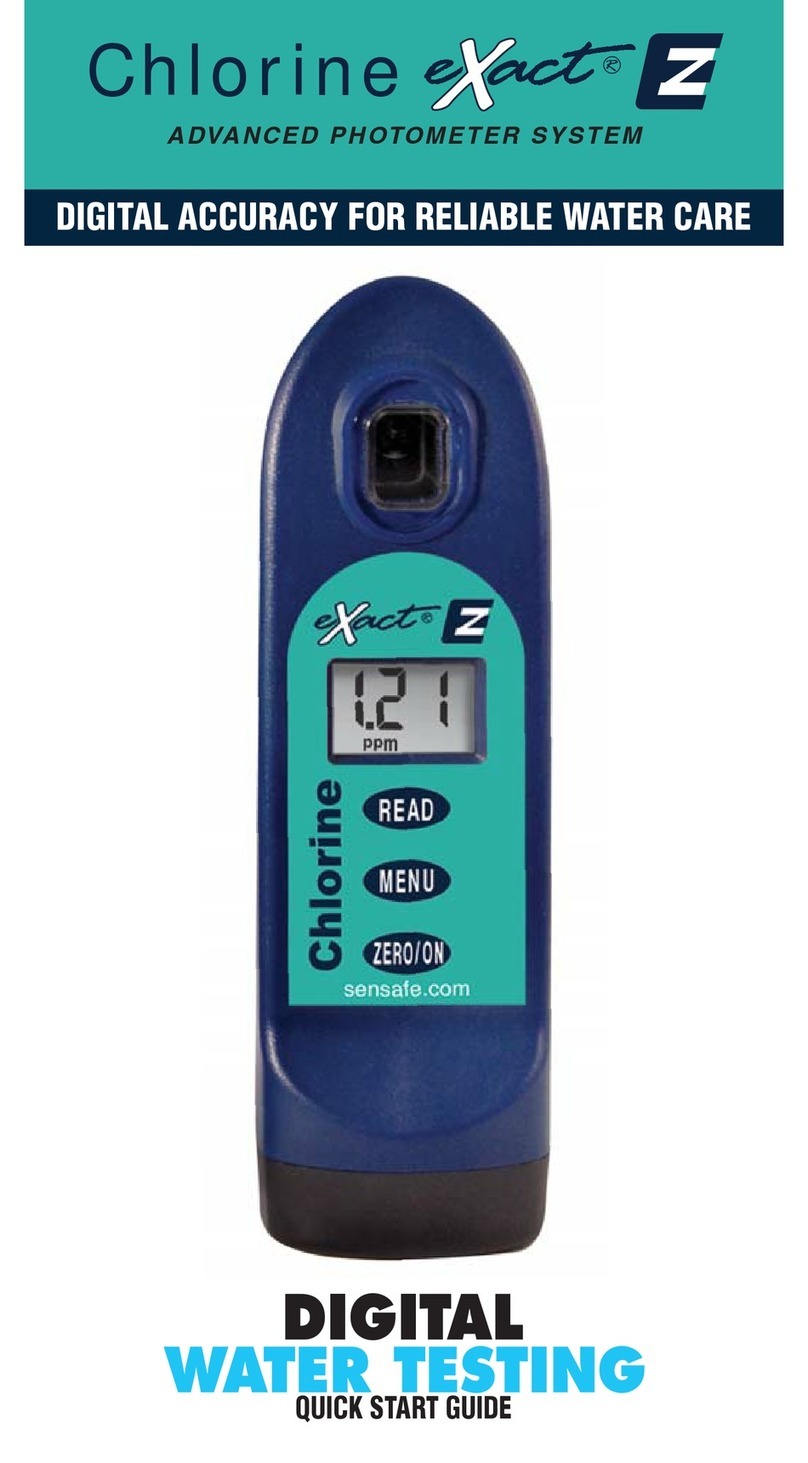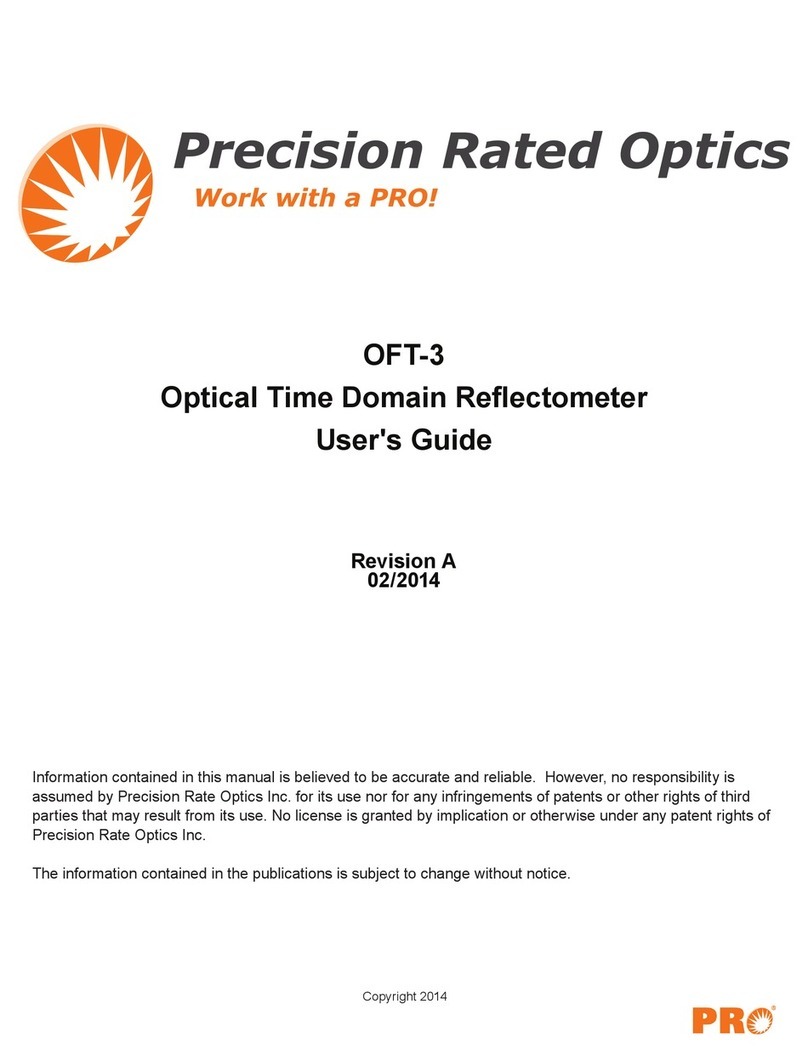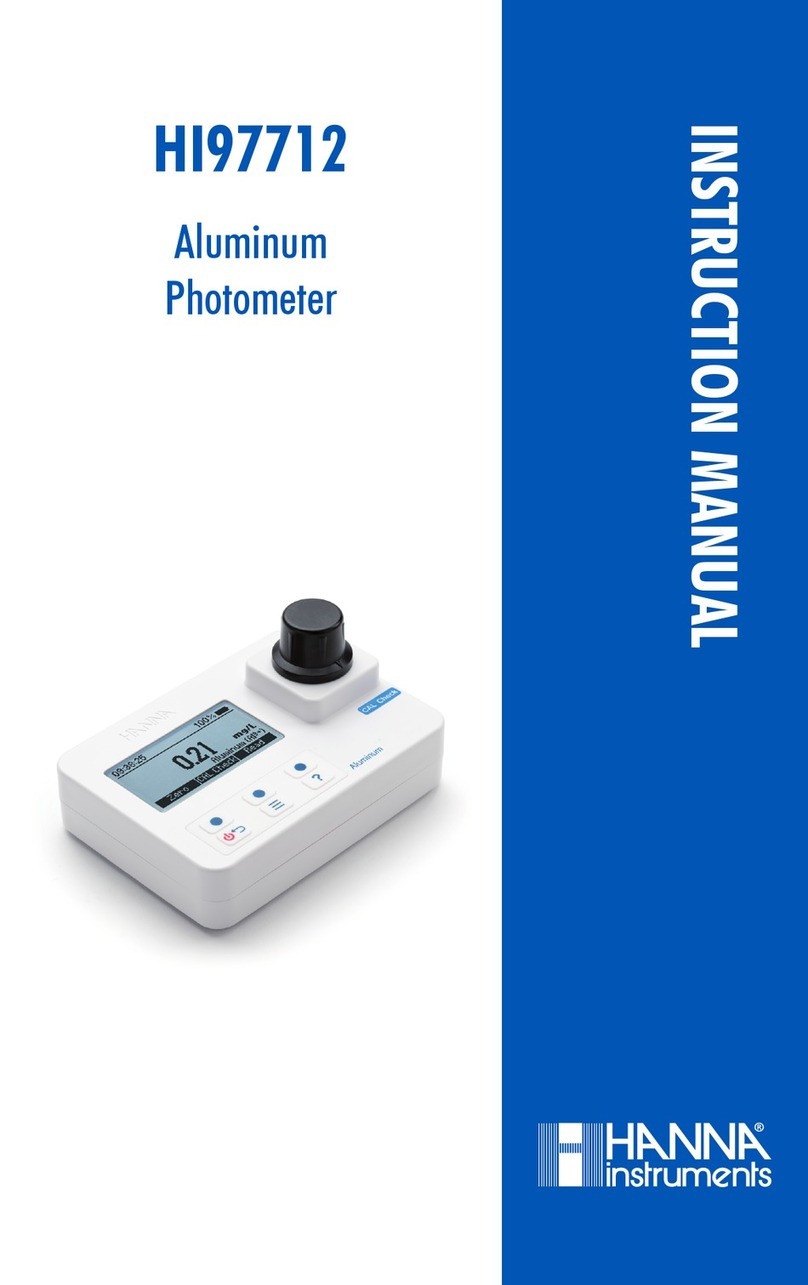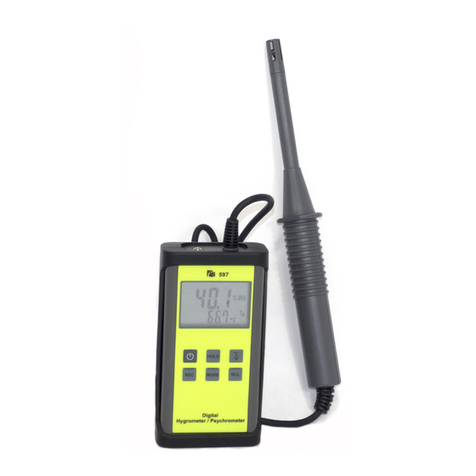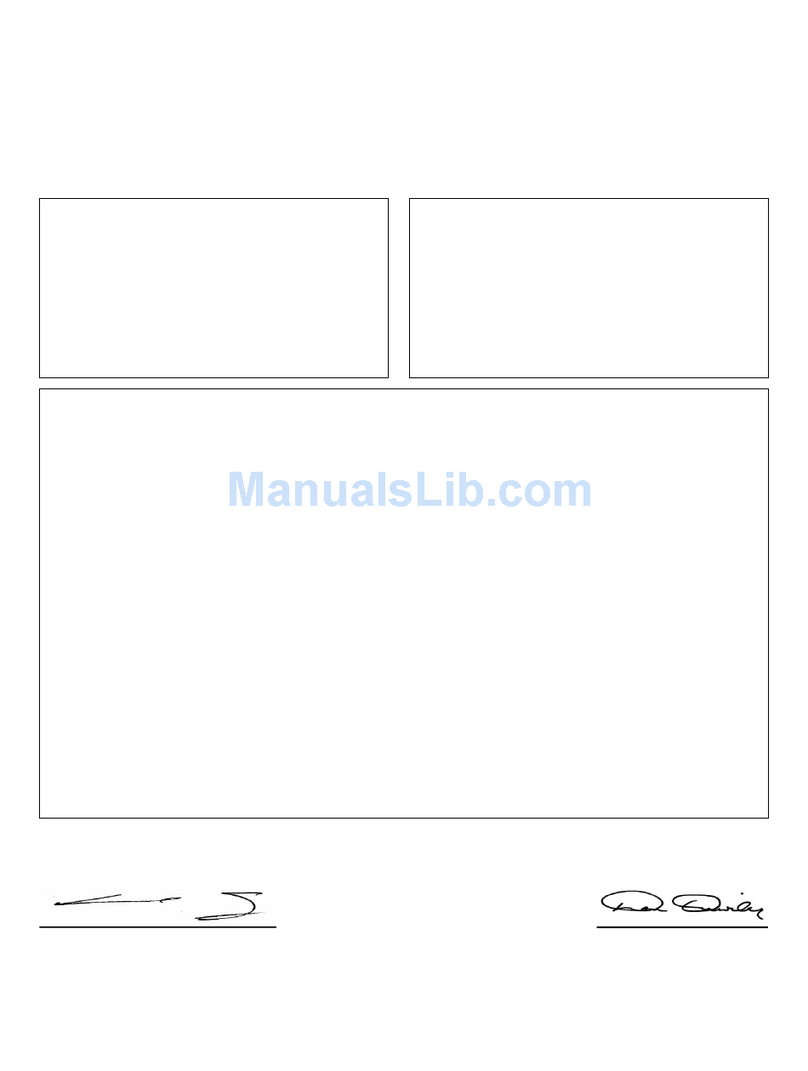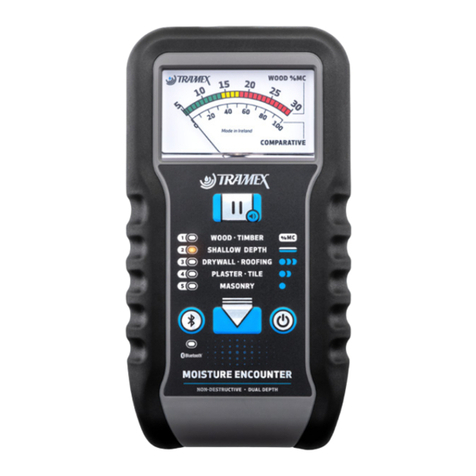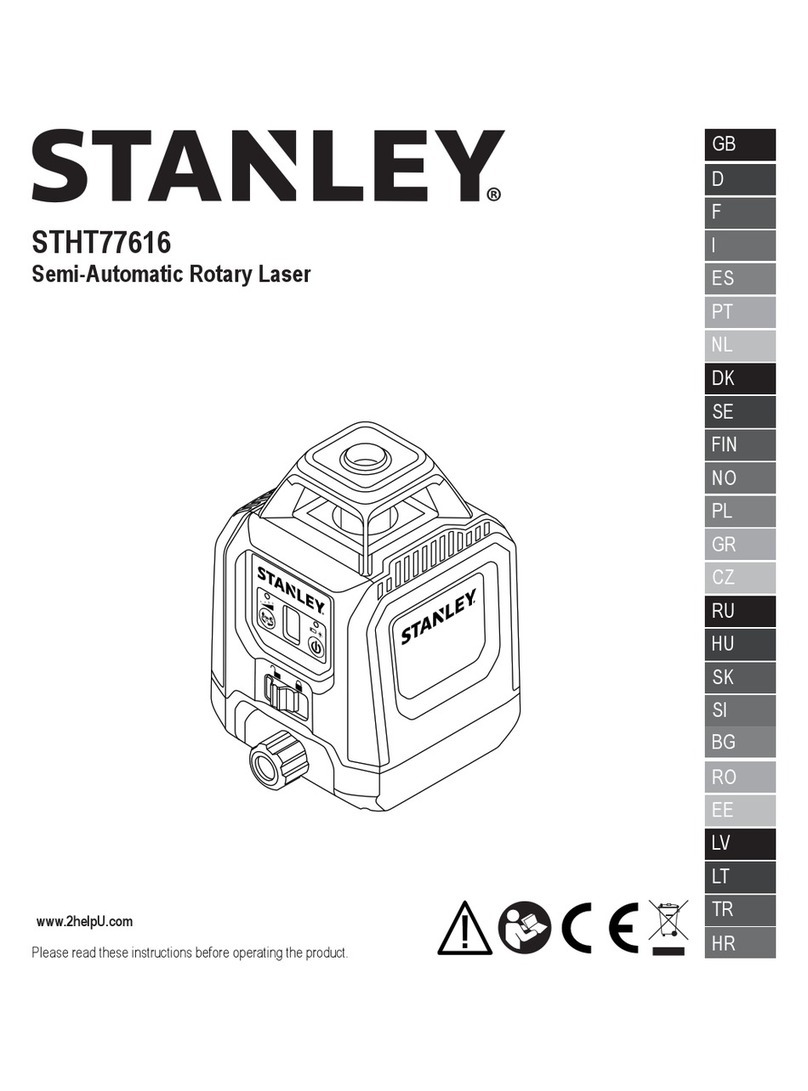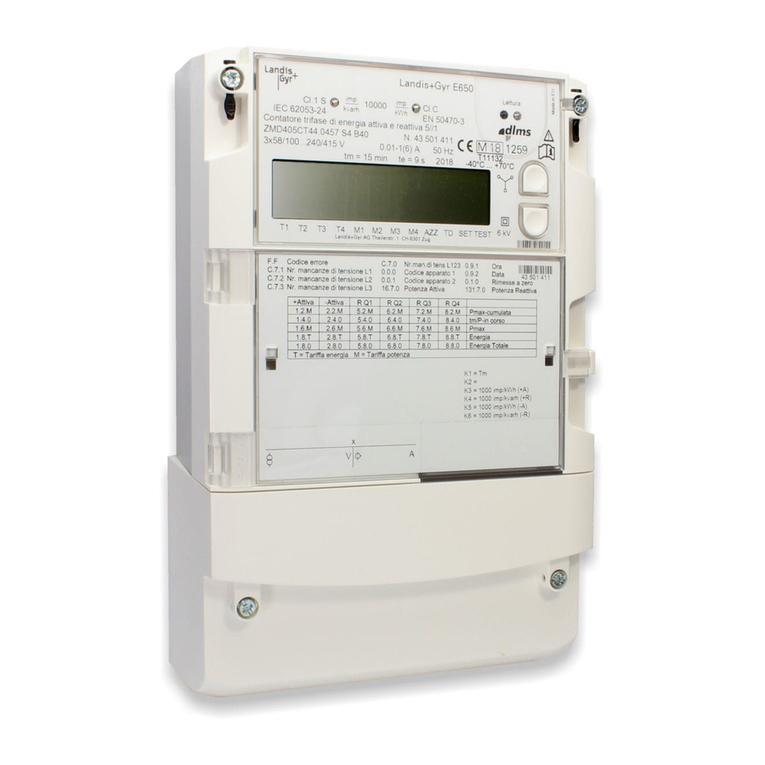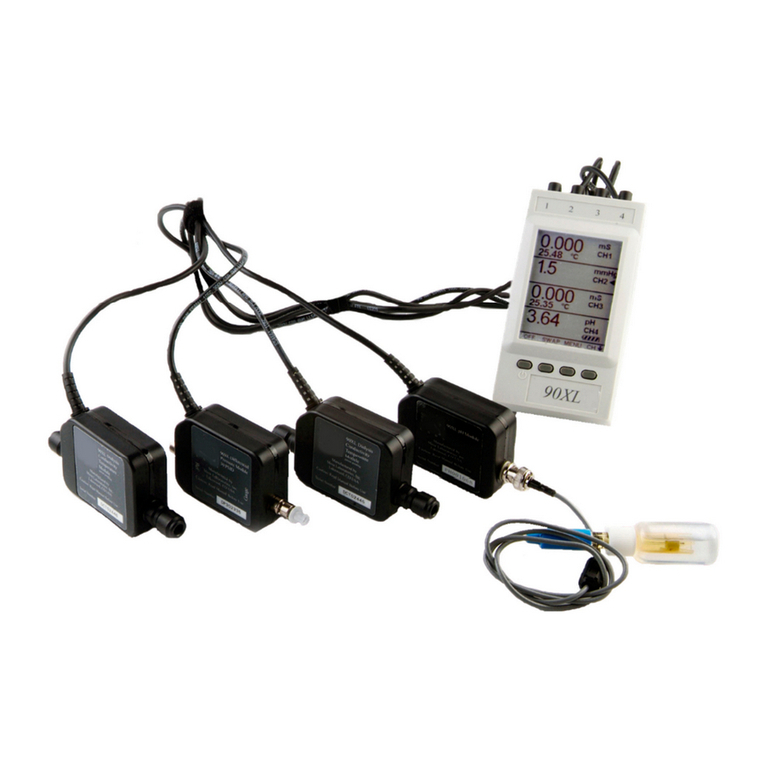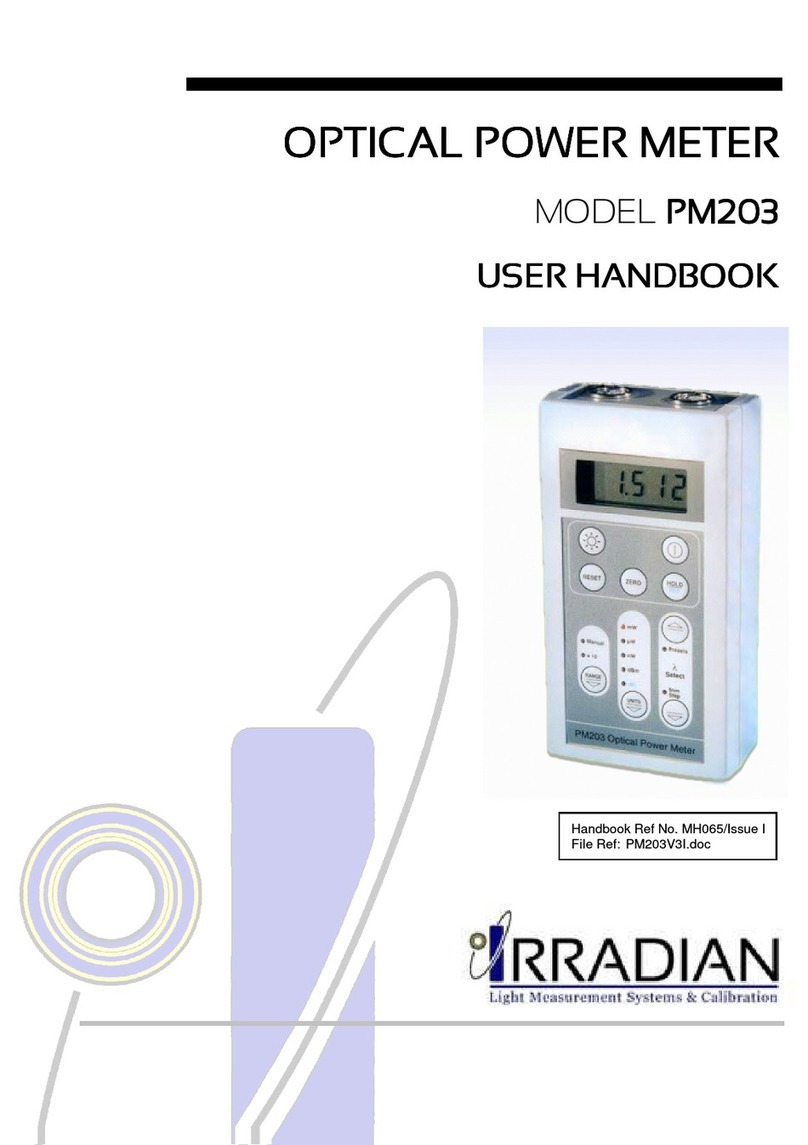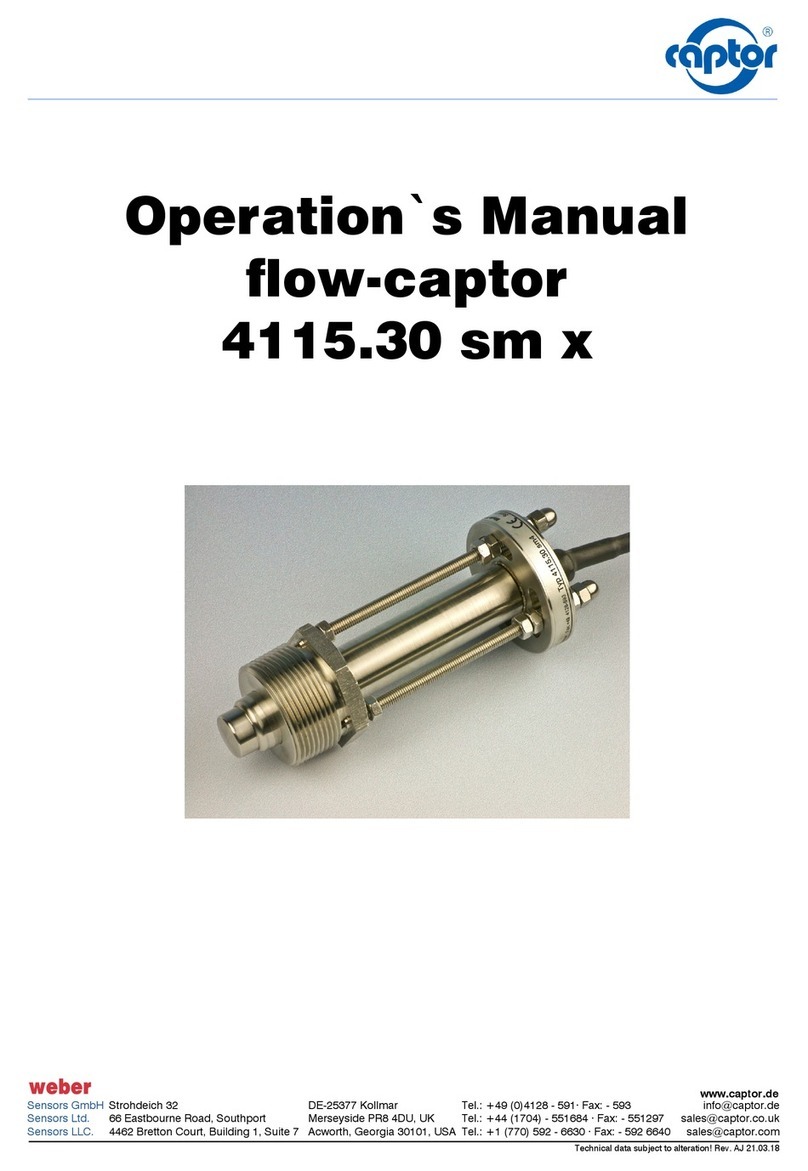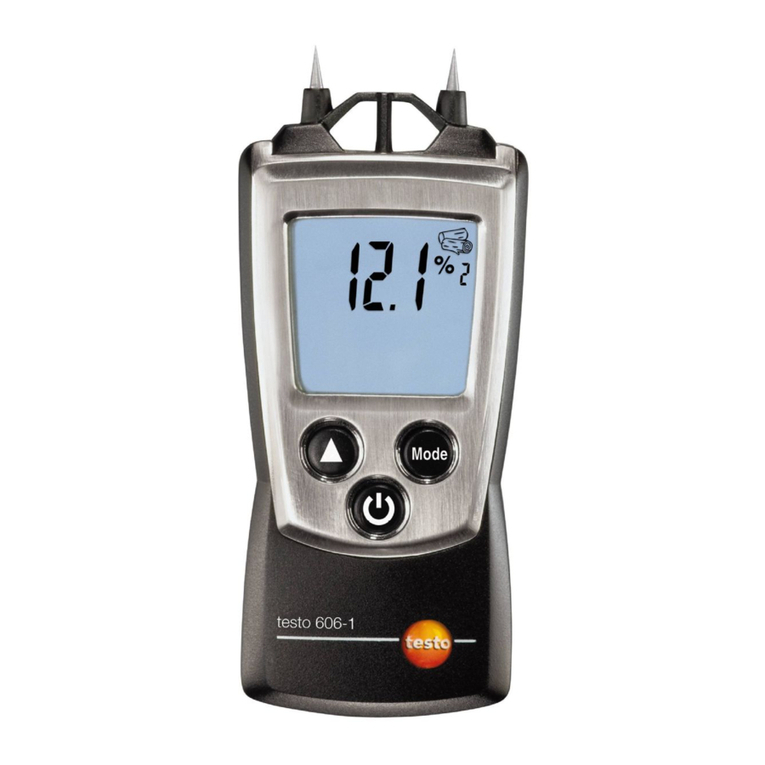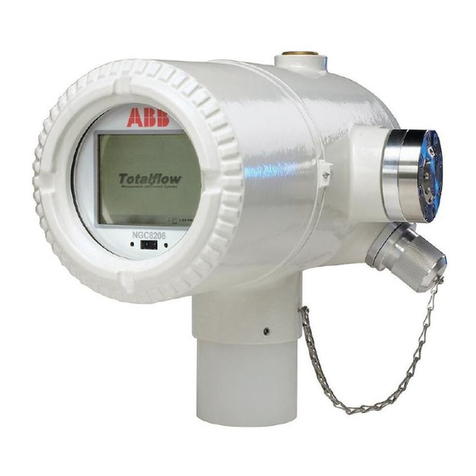Sensafe eXact LEADQuick User manual

Ideal for Screening for Lead, Mercury,
and Cadmium in Potable Water
(For Lead Soil Testing, see page 15)
Instruction Manual
Manufactured by:
Industrial Test Systems, Inc.
www.SENSAFE.com
©2013 Industrial Test Systems, Inc. • EXACT® and LEADQuick™are
trademarks of Industrial Test Systems, Inc., Rock Hill, SC, USA
Revision 02/20/13
For use with eXact®
LEADQuick™Photometer
For Your Safety:
Please read the entire manual
before using the test kit.
Contains 50 Tests
U.S. Patent No. 7,333,194
South African Patent
# 2007/0628;
and other patent
applications including:
International Patent
Appln. No. PCT/US2005
/033985; and EU Patent
#1,725,864
This Instruction Manual does not include a
test procedure for Lead in paint. Visit
www.sensafe.com for details.
Parameter Page MENU
Lead in Water 2 PB2
Mercury in Water 3 HG3
Cadmium in Water 4 CD4
Spiked Recovery Method 5
Tips for Best Accuracy 6
Instrument Operation 7
ReadySnap™ 1 Procedure 7
Kit Specifications 8
Battery Installation 9
Warranty (2 year) 9
Lead Recovery Samples 10
Summary of Chemistry 11
Lead Test Interferences 12
MSDS Sheets 13-14
Lead in Soil Method 15
Kit Components 16
Kit Number 486900-W (Lead and Mercury)
486900-W

Lead in Water Test Procedure
Uses Reagent Set 486901.
7
5
Add five (5) drops of
eXact
®
Reagent Pb-2, Part
No. 488375-B
.
ADD REAGENT Pb-2
5
Using the TEST SAMPLE from above, fill and empty
the CELL four (4) times. Finally, fill cell to capacity
(4ml) with the TEST SAMPLE. Tilt meter forward to
allow excess sample to flow out in order to make room
for Pb-2 Reagent addition below.
ADD SAMPLE TO CELL
4
Dip the eXact
®
Strip Pb-3, Part No. 486997 into
the CELL and immediately press READ. This starts
the 20 SECOND countdown timer. During this time
move the strip in a gentle back and forth motion.
Remove and discard the strip after “1” on the display
The display will flash (- - -) and begin
immediately counting up from 1 to 60. After the 60
seconds, the meter automatically zeros. The cursor
will move across the display followed by 0 µg (µg/L).
DIP STRIP AND PRESS “READ”
6
Dip the eXact
®
Strip Pb-4, Part No. 486995 into
the CELL and immediately press READ. This starts
the 20 SECOND countdown timer. During this time
move the strip in a gentle back and forth motion.
Remove and discard the strip after “1” on the
The display will flash (- - -) begin immediately counting
up from 1 to 60. After the 60 seconds, the cursor
will move across the display, informing you that it is
about to measure the sample as µg (µg/L). Record
result (this result is automatically stored in PB2).
After testing is complete discard sample and rinse
cell at least three times with clean water.
DIP STRIP AND PRESS “READ”
7
Collect water sample in 50mL conical tube to the 50mL
line. Add five (5) drops of ACID-1 Reagent, Part No.
486999. Mix and allow to sit for at least five (5)
minutes. After this time, TEST SAMPLE is ready for
testing.
PREPARE SAMPLE FOR TESTING
1
PB
PB2
Press and re-press the MENU button until the
display shows the parameter PB2.
SELECT TEST: PB2
3
Press the ZERO/ON button to power the meter on;
the display will show all annunciators, then the current
MENU selection, followed by the last reading.
TURN METER ON
2
2
1
6
4
3
2

3
Mercury in Water Test Procedure
HG HG3
Add five (5) drops of
eXact
®
Reagent Pb-2, Part
No. 488375-B
.
ADD REAGENT Pb-2
5
Using the TEST SAMPLE from above, fill and empty
the CELL four (4) times. Finally, fill cell to capacity
(4ml) with the TEST SAMPLE. Tilt meter forward to
allow excess sample to flow out in order to make room
for Pb-2 Reagent addition below.
ADD SAMPLE TO CELL
4
Dip the eXact
®
Strip Pb-3, Part No. 486997 into
the CELL and immediately press READ. This starts
the 20 SECOND countdown timer. During this time
move the strip in a gentle back and forth motion.
Remove and discard the strip after “1” on the display
disappears.
The display will flash (- - -) and begin
immediately counting up from 1 to 60. After the 60
seconds, the meter automatically zeros. The cursor
will move across the display followed by 0 µg (µg/L).
DIP STRIP AND PRESS “READ”
6
Dip the eXact
®
Strip Pb-4, Part No. 486995 into
the CELL and immediately press READ. This starts
the 20 SECOND countdown timer. During this time
move the strip in a gentle back and forth motion.
Remove and discard the strip after “1” on the
display disappears.
The display will flash (- - -) and begin
immediately counting up from 1 to 60. After the 60
seconds, the cursor will move across the display,
informing you that it is about to measure the
sample as µg (µg/L). Record result displayed (this
result is automatically stored in HG3). After testing is
complete discard sample and rinse cell at least
three times with clean water.
DIP STRIP AND PRESS “READ”
7
Collect water sample in 50mL conical tube to the 50mL
line. Add three (3) drops of ACID-1 Reagent, Part No.
486999. Mix and allow to sit for at least five (5)
minutes. After this time, TEST SAMPLE is ready for testing.
PREPARE SAMPLE FOR TESTING
1
Press and re-press the MENU button until the
display shows the parameter HG3.
SELECT TEST: HG3
3
Press the ZERO/ON button to power the meter on;
the display will show all annunciators, then the current
MENU selection, followed by the last reading.
TURN METER ON
2
Uses Reagent Set 486901.
5
1
4
7
6
2
3

4
Add five (5) drops of
eXact
®
Reagent Pb-2, Part
No. 488375-B
.
ADD REAGENT Pb-2
5
Rinse the CELL at least 3 times with the TEST
SAMPLE above. Finally, fill cell to capacity (4ml) with
the TEST SAMPLE. Tilt meter forward to allow excess
sample to flow out in order to make room for Pb-2
Reagent addition below.
ADD SAMPLE TO CELL
4
Dip the eXact
®
Strip Pb-3, Part No. 486996 into
the CELL and immediately press READ. This starts
the 20 SECOND countdown timer. During this time
move the strip in a gentle back and forth motion.
Remove and discard the strip after “1” on the display
disappears.
The display will flash (- - -) and begin
immediately counting up from 1 to 240. After the 240
seconds, the meter automatically zeros. The cursor will
move across the display followed by 0.00 mg (mg/L).
DIP STRIP AND PRESS “READ”
6
Dip the eXact
®
Strip Pb-4, Part No. 486995 into
the CELL and immediately press READ. This starts
the 20 SECOND countdown timer. During this time
move the strip in a gentle back and forth motion.
Remove and discard the strip after “1” on the display
disappears.
The display will flash (- - -) and begin
immediately counting up from 1 to 240. After the 240
seconds, the cursor will move across the display,
informing you that it is about to measure the sample
as mg (mg/L). Record result displayed (this result is
automatically stored in CD4). After testing is complete
discard sample and rinse cell immediately.
DIP STRIP AND PRESS “READ”
7
Collect water sample in 50mL conical tube to the 50mL
line. Add five (5) drops of HCl-1 Reagent, Part No.
486994. Mix and allow to sit for five (5) minutes. After
5 minute wait, TEST SAMPLE is ready for testing.
PREPARE SAMPLE FOR TESTING
1
Press and re-press the MENU button until the
display shows the parameter CD4.
SELECT TEST: CD4
3
Press the ZERO/ON button to power the meter on;
the display will show all annunciators, then the current
MENU selection, followed by the last reading.
TURN METER ON
2
Cadmium in Water Test Procedure
CD
CD4
Uses Reagent Set 486904.
5
1
4
7
6
2
3

Spiked Recovery Test Method for Interferences:
The Spiked Recovery Test Method (also referred to as Standard Additions Method) is used to verify that
LEADQuick
™
gives accurate results for your water sample. If you find an unexplained difference in results
when compared to another test method it is reasonable that you should resolve the issue. A good way to
resolve the issue is by a technique commonly used by analytical chemists every day. This technique is often
referred to as Spiked Recovery Test Method for Interferences. The following information explains how to
perform the test method. You will need a Lead standard solution. The idea behind this method is as follows:
1. Add a known amount or concentration of Lead standard solution to the questionable sample. This is
now the “spiked sample.” It is recommended to add a Standard Solution amount that is at least equivalent
to three times the minimum detectable limit of the test (10 µg/L or ppb).
2. Test the spiked and un-spiked (original) samples using the same reagents, instrument and technique
or test method. The spiked sample should show an increase equal to the amount of standard added. The
value obtained is called the Recovery. Ideally the % recovery is 100%. Results are acceptable if the %
recovery is +/- 10%. The formula for calculating percent Recovery is below.
3. If the percent recovery is not in the acceptable range there may be interferences. You can consider
diluting the sample with lead free water past the point of interference, within the detection limit of the
test kit. You can also consider calculating the actual lead in the sample (see below) as long as the %
Recovery is above a reasonable level such as 40%.
The percent recovery formula is as follows:
% Recovery = 100(cs-cu)
K
Where:
cs = concentration found through testing of the spiked sample
cu = concentration found through testing of the un-spiked sampl e
(NOTE: result should be adjusted for the dilution of the spike volume if volume change
is more then 5%)
k = concentration of the spike added to the sample
Example 1: An un-spiked questionable sample measures 10 ppb Lead. A separate 10 mL portion of the
questionable sample was spiked by adding 20 µL of a 10 ppm Lead standard solution. This is the equiva-
lent of adding 20 ppb Lead to the water sample. The spiked solution was measured by the same method
as the original sample. The Spiked result was 28 ppb (Cs)
cs = 28 ppb
cu = 10 ppb
k = 20 ppb
% Recovery = 100(28-10) = 90% (Recovery result acceptable)
20
Example 2: In another water sample using a similar spiked method as in Example 1 the results were
cs = 30 ppb
cu = 18 ppb
k = 20 ppb
% Recovery = 100(30-18) = 60% (Recovery result unacceptable)
20
Calculating the Lead:
In this example the percent recovery value is low and suggests that, with this test, the
water sample gives lead results that are 60% of the actual concentration. To calculate the concentration
of lead in this sample divide the expected recovery (100%) by the observed recovery (60%) to get the
interference correction factor (100% / 60% = 1.67). Multiply the interference correction factor by the
un-spiked sample result (cu) for the actual concentration of lead in the sample (1.67 x 18 ppb = 30 ppb).
5

1.
2.
3.
4.
5.
6.
7.
8.
9.
10.
11.
12.
13.
14.
Become familiar with the meter and the different tests by reading the instructions carefully.
Observe the dip time (as required for the test) for accurate results.
Be sure the CELL is filled to capacity (4ml). Then, tilt meter forward to discard about
0.2mL of the cell volume. This allows for the Pb-2 addition to be performed without
overfilling the CELL.
Rinse the CELL with clean water immediately after completing the test. (Some test
reagents will stain or coat the CELL)
It is recommended that the sample be allowed to sit for 5 minutes or longer in Step 1 to
facilitate Acid reaction. Additional time would be recommended if the detection of solid Lead
or Cadmium, containing particles, are of interest.
Store the meter and all test materials out of direct sunlight and away from chemical storage areas.
Minimize exposure of meter and test reagents to heat. Storage below 80°F (27°C) is
recomended. DO NOT REFRIGERATE TEST REAGENTS.
Dry the outside of the meter when testing is complete or before storage of the meter.
Each eXact®Strip Micro is valid for ONLY one test. Discard strip after single use in regular
trash that is inaccessible to children and pets.
Each bottle of eXact®Strip Micro contains the quantity of strips notated on the bottle. Due
to the manufacturing process, you may find one or two strips that are noticeably smaller or
larger in width than the normal strips in the bottle. These should be discarded. Using these
strips may give unreliable results.
If conversion table(s) are supplied, they have a unique revision number. It is recommended
that you visit www.sensafe.com to check for any updated revisions and details.
Tests are calibrated at 75°F +/- 2°F (24°C +/- 1°C). It is recommended that the water sample
be warmed before testing if sample temperature is below 60°F / 16°C.
Our lab testing with the LEADQuick meter has shown that zeroing and measuring of the
sample does not require any cell cover for accurate results, even in full sunlight.
Remove batteries when meter is not used for more than a month.
eXact®LEADQuick Tips For Best Accuracy
Lead in Water Recomendation for “First Draw Sample”
The EPA 2007 Lead and Copper Rule Revision has a heavy lead testing focus on schools.
The sampling is tiered:
1. “First draw sample” - sample a line unused for at least 8 to 18 hours. Draw the first
250mls to test. This measures the lead contribution from fixtures.
2. “Flushed sample” - before any water is used in the morning allow the line to run for 30
seconds, and then collect a 250ml sample. This measures the lead contribution from
internal piping
The June 1991 Lead and Copper Rule Fact Sheet recommended 1 liter of water from a
tap unused for 6 hours. This is not mentioned in the 2007 revisions to the rule.
The amount of flushing determines what part of the system is being evaluated for lead. If
the volume of water in the system can be determined (e.g. gallons of water/linear ft. of
pipe) the amount of flushing can help isolate the source of the lead contamination. It
appears that this approach is used by some cities as they do mandated lead testing of their
water systems.
6

Instrument Operation Summary
Key Functions
Key Description Function
ZERO/ON While meter is off, when pressed, this turns meter on.
When meter is on, when pressed, this zeros meter.
READ When pressed, this initiates countdown timing and
count up timing as appropriate for the MENU test.
MENU When pressed and re-pressed, this advances the
display to the next MENU test. When pressed and held
down for two seconds (continue holding down), the
instrument automatically retrieves the last 20
measurements in the MENU displayed. Beginning with
the most recent measurement stored (20) through the
oldest measurement stored (1). This recall is available
for each MENU test.
7
1. Snap off top of ReadySnap™1 vial safely and add one (1) drop of Acid-1 (486999) to
Solution in ampoule.
2. Mix Solution by sucking up liquid with plastic pipette.
3. Turn on eXact®LEADQuick™meter and scroll to PB2 MENU.
4. Using pipette, fill meter CELL with Solution and then empty cell.
5. Fill meter CELL again with Solution and tilt meter forward to make room for Pb-2
Reagent.
6. Add five drops of Pb-2 Reagent (488375-B).
7. Dip Pb-3 Strip (486997) into cell and immediately push READ. Move strip in a
gentle, back and forth motion (approx. 2 strokes/Sec) for 20 seconds. Remove strip
after “1” on the display disappears.
8. Display will flash and automatically start to count up from 1 to 60. After the 60
seconds, meter automatically zeros.
9. Dip Pb-4 Strip (486995) into cell and immediately press READ. Move strip in a
gentle, back and forth motion (approx. 2 strokes/Sec) for 20 seconds. Remove strip
after “1” on the display disappears.
10. Display will flash and automatically count up from 1 to 60. After the 60 seconds, the
cursor will move across display while the meter prepares to measure the sample. Record
results displayed (this result is automatically stored in PB2 Menu).
11. After testing is completed, rinse CELL at least three times.
ReadySnap™1 Test Procedure
Method Verification Solution for Testing
When there is a question about the quality of a ReagentStrip™, your test method, or the
photometer you are using, then it is recommended to test the SYSTEM (reagent, you,
and photometer) by using the appropriate READY SNAP™solution.
Follow the procedure below for the test you are running. If you get the acceptible result
using the READY SNAP™solution, then you can be confident that the reagent, you, and
the photometer are working as a SYSTEM correctly.

G
H
+
–
eXact®LEADQuick™Meter Specifications
Measurement Method: Photometric
Light Source: Light Emitting Diode (LED)
Wavelength: 476 nm
ABS Range: .001 - 2.00
Photometric Precision: .001
Automatic Range Selection: See Specifications below
Display: 3-digit customized liquid crystal display
with annunciators
CELL Pathlength: 20mm
Cell Chamber: Custom-molded, proprietary, PET plastic
fused into chamber, non-removable
Sample Required: 4 ml (0.13 oz)
Operating Temperature Range:
0 - 50°C (32° - 122°F)
Power Supply: (4) AAA alkaline batteries Not Included
Battery Life: 2000 tests with alkaline batteries
Electromagnetic Compliance:
Emitted Interference - EN 61326
(EMC) Immunity to Interference - EN 61326
Waterproof Rating: Exceeds IP67
Weight: Instrument: 140 g (5 oz)
Dimensions: Instrument: 5 (W) x 3.5 (D) x 16.5 (H) cm;
(2 x 1.4 x 6.375 in)
We offer a “Green” Alternative
eXact®LEADQuick Photometer
F
E
D
C
B
A
ITEM PICTURED
LETTER
COMPONENT
NAME
AMixing Cap
BCell (Built-in Plastic, 4 ml)
CLCD Display
DREAD Button
EMENU Button
FZERO/ON Button
G
Battery Cover with loop for lanyard
H
AAA Batteries (x4) NOT INCLUDED
eXact
®
LEADQuick has been designed to offer the user a more “Green” and cost-effective alternative to testing.
Instead of using a 10ml water sample, eXact
®
LEADQuick uses a 4ml water sample, which uses up to 60% less
chemical per test. The accuracy of the meter is maintained by designing the photo cell with a 20mm pathlength.
8
Menu Tests for Range Resolution +/- Accuracy Limit*
PB2 Lead in Water (auto-zero) 1 - 500 µg/L 1 µg/L 3 µg/L or 6% 3 µg/L
HG3 Mercury in Water
(auto-zero)
10 - 600 µg/L 1 µg/L 6 µg/L or 6% 10 µg/L
PA1 Diluted Homogenized .000 to 1.99 .001 .003 or 6% —
Paint Lead
CD4 Cadmium in Water
(auto-zero)
0.01 - 0.80 mg/L .01 mg/L .06 mg/L or 6% .02 mg/L
PB6 Lead in Water 1 - 500 µg/L 1 µg/L 3 µg/L or 6% 3 µg/L
AB5 Future or Custom Tests .000 - 1.99 .001 .002 or 2% —
(Absorbance) abs abs abs
eXact®LEADQuick™Specifications
*Limit is defined as the minimum reliable detection for that test. Any value below the limit should be
considered inconclusive for that metal’s presence.
PB2
Lead extracted from Ceramic
1 - 500 µg/L 1 µg/L 3 µg/L or 6% 3 µg/L
PB2
Modified Test for Lead in Soil
18 - 3000 mg/kg 1 mg/kg + - 25% 18 mg/kg
200 - 300,000 200 + - 40% 200
mg/kg

The following are some common messages that may be displayed, including error messages. If an
error message other than those listed below is displayed, please contact technical support in the USA
at (803) 329-0162 (ext. 0).
LCD Message
HI
LO
LO
ER
Description
In READ mode: test sample concentration is above
the measurement range (test specific).
In READ mode: test sample concentration is below
the measurement range (test specific).
In ZERO mode: sample absorbance (due to a
cloudy or colored sample or a dirty cell) is too high
to zero, the meter will read “LO”.
Excessive stray light detected. Normally this
does not occur, even when testing in sunlight.
Low battery indication.
Corrective Action
Dilute and retest. Dilution Kit available
(Part Number 487200)
Sample value is below measurement
range.
Dilute sample, filter sample, or clean cell.
Testing cannot proceed until a valid ZERO is
acheived.
Place the LIGHT BLOCKING CAP over the CELL
for zeroing and for reading result. Moving
to a shaded area can also fix this problem.
Replace the batteries.
About The Built-In Cell
The built-in CELL is transparent plastic and, when filled to the top, contains 4ml. The sturdy CELL
design will last for over 20,000 readings. Scratches on the CELL will not interfere or compromise
the accuracy of the readings because of its fixed position. For best accuracy, rinse cell with clean
water immediately after a test is completed. Do not use solvents, such as acetone, to clean the
cell. When the CELL becomes stained or cloudy from repeated testing, or when the meter does
not blank when you press the ZERO/ON button, the cell needs to be cleaned. Clean as follows: Fill
cell with clean water and add two drops of Acid-1 or HCl-1. Leave meter undisturbed for 5
minutes. Afterwards, rinse the cell and the meter is ready for use again. Cleaning the cell
regularly will not be necessary if you rinse the CELL immediately after the test.
eXact®LEADQuick Meter Messages
eXact®Photometer 2-Year Limited Warranty
Registration of your eXact
®
photometer must be received within 30 days from date of purchase to
activate the warranty. The eXact
®
photometer is warranted to be free from defects in materials and
workmanship for a period of two (2) years from the date of purchase by the customer. ITS will repair
or replace any part of the product which is deemed to be faulty or otherwise defective. The
non-transferable warranty does not cover product damage caused by abuse (such as crushing a tablet
in the cell) or improper use. If the meter is faulty or otherwise defective contact ITS by phone
authorization form before returning the photometer to ITS. Damage caused by improper packing of the
photometer for return shipment to ITS will not be covered by the warranty. Customer is responsible for
shipping charges to ITS. ITS pays postage when photometer is returned to customer. A maximum
processing fee of $120 will be charged for repair or replacement of non-registered photometers and
damages not covered by this warranty. Registration is available over the phone (+1-803-329-9712
Ext. 0) or online at http://www.sensafe.com/micro/warranty/ (Personal data is kept confidential).
1. Unscrew the O-ring sealed battery cover counter-clockwise. Use proper sized pliers if
necessary. Do not disturb the sealing O-ring. Batteries are not included.
2. Remove the used batteries and install 4 new AAA batteries following the diagram for
correct polarity (see diagram). We recommend high quality AAA alkaline batteries be used.
4. Replace the battery cover. Be sure to tighten the cover securely. This is necessary for meter
to be waterproof.
5. Dispose of the used batteries in accordance with
your local regulations.
6. Press ZERO/ON button to confirm the meter
turns on. The meter is now ready for operation.
7. Meter will not work if battery orientation is incorrect.
To Install/Replace “AAA” Batteries:
TOP VIEW
9

Water Sample 20ppb % 50ppb %
Water Origin Type µg/L ppb (ug/L) Recovery ppb (ug/L) Recovery
Vienna, Austria M 0 21 105 52 104
repeated 0 19 95 51 102
Munich, Germany M 0 21 105 54 108
repeated 0 19 95 46 92
Kusnacht, Switzerland M 0 20 100 51 102
repeated 0 19 95 54 108
Paris, France M 0 19 95 50 100
repeated 0 20 100 45 90
Washington, DC M 0 23 119 52 104
repeated 0 20 100 49 98
Philadelphia, PA M 0 17 85 45 90
repeated 0 23 119 43 86
Phoenix, AZ M 0 20 100 47 94
repeated 0 21 105 47 94
Edgewater, MD W 0 22 110 50 100
repeated 0 16 80 46 92
Highland, NC W 0 15 75 36 72
repeated 0 15 75 37 74
Rockwell, NC W 0 22 110 51 102
repeated 0 23 119 50 100
Las Vegas, NV M 0 19 95 52 104
repeated 0 17 85 49 98
Chicago, IL M 0 21 105 51 102
repeated 0 16 80 52 104
Rock Hill, SC W 0 18 90 47 94
repeated 0 17 85 46 92
Melbourne, Australia M 0 20 100 47 94
repeated 0 19 95 45 90
Rock Hill, SC
(exposed to lead) M 5 25 100 56 102
repeated 5 26 104 52 95
Weaverville, NC M 0 16 80 52 104
repeated 0 20 100 46 92
Anaheim, CA M 0 19 95 53 106
repeated 0 21 105 47 94
Seattle, WA M 0 16 80 45 90
repeated 0 16 80 42 84
Kilowna, BC, Canada M 0 19 95 51 102
repeated 0 21 105 53 106
*M = Municipal, W = Well
Water Spiked Spiked
Lead Recovery in Various Water Samples:
Our laboratory has performed numerous Spiked Recovery tests using water samples from
around the world. The water samples were obtained in the locations as identified below. The
water was collected in clean plastic bottles and shipped to our lab. The samples were not pre-
served by acid and not refrigerated.
Each sample was spiked in duplicate at two different spiked concentrations (20µg/L and 50µg/L)
giving a total of four spiked tests. Except for two water samples the % recovery of spiked water
samples had an acceptable average for the four spiked water tests (within +/- 10%). The Highland,
NC well water averaged a 74% Recovery and the Seattle, WA municipal water averaged 83.5%
Recovery.
Water sample lead (Pb+2) concentrations found for all samples were below 3ppb, and reported
as 0, except for Rock Hill, SC water (exposed to lead).
10

Summary of LEADQuick
™
Chemistry for Lead (Pb
+2
) Detection:
Lead in the water sample is first solubilized to Pb+2 by the addition of the Nitric Acid
reagent. Pb-2 Buffer is then added to make the solution alkali. The eXact® Strip Pb-3
is dipped for 20 seconds with gentle motion, which adds the porphyrin indicator, and
mixes the solution. After a one minute wait, which allows for the porphyrin and Pb+2
to form a colorimetric complex, the eXact® LEADQuick™ Colorimeter automatically
zeros. The eXact® Strip Pb-4 is dipped into the cell sample for twenty seconds with
gentle motion. This motion releases EDTA into the sample which then breaks up the
colorimetric porphyrin-Pb2+ complex. After a one minute wait, the result is displayed
in µg (µg/L) as Lead. The Mercury test uses a similar chemistry. Cadmium uses
Hydrochloric Acid for solubilization of the Cadmium ion, and this test requires more
indicator reagent.
A procedure using the porphyrin 5,10,15,20-terakis(1-methylpyridinium-4-yl)por-
phine as indicator is described in Mirochim Acta volume 157, page 87-91 published
in 2007 K. Kawamura, et al. For convenience the indicator is referred to as TMPYP.
Our modified test procedure is patented. In combination with the eXact®Strip
reagent delivery device, and by not removing the cell from the meter between the
zeroing and reading steps; LEADQuick™ delivers optimum accuracy and sensitivity.
Please refer to the Lead Test Interference chart (Table 1) for details as to the
highest concentration of ions the test can tolerate. From our lab and contract lab
studies with LEADQuick™ we find that over 90% of the typical potable, municipally
treated water samples experience no interference. Before you start using the
LEAD-Quick™ with potable water samples in your area use the “Standard Additions”
method to determine if there are any interferences in your water that may require
consideration.
Interfering ions listed, except for Mercury and Cadmium, inhibit the TMPYP-Pb+2
complex formation above the concentrations given. Mercury and Cadmium give
similar color reaction with TMPYP. Mercury is rarely found in tap water above 0.005
mg/L. A procedure modification is not yet available to remove Mercury interference.
Typical Cadmium levels in tap water will not interfere in the Lead and Mercury
procedures using Nitric Acid. Hardness ions such as Calcium and Magnesium are
tolerated as noted in Table 1. When the water sample has Total Hardness minerals
above 400 mg/L, the Pb-4 addition of EDTA may be inadaquate; and the TMPYP-Pb+2
complex may not be completely destroyed and the lead reading will be low. If you
suspect this, do a Spiked Recovery Test (page 5).
It is recommended that for best results this test be done on unpreserved, freshly
drawn water samples. Water samples that have been preserved with strong Nitric
Acid for lead testing will require alkali neutralization of excess acid to a pH of about
2.5; and the Acid-1 addition can be skipped. After the Pb-2 addition step the pH
should be verified if pH issue is a concern; and ideally should be between 9.0 and
9.6 pH.
A test kit is also available for detection of Lead in paint. Contact our Sales
Department for details, or go to www.sensafe.com.
11

About your Water Sample:
Kit Specifications:
Lead Test (PB2 & PB6 MENU) Interferences
(Similar interferences can be expected for Mercury and Cadmium Tests.)
Ion Interference
Level Ion Interference
Level
Aluminum, Al
3+
2 mg/L Magnesium, Mg
2+
200 mg/L
Barium, Ba
2+
3 mg/L Manganese, Mn
2+
0.5 mg/L
Calcium, Ca
2+
500 mg/L Nitrogen, Ammonium, NH
4
+
40 mg/L
Chloride, Cl
-
150 mg/L Nitrogen, Nitrate, NO
3
-
Nitrogen, Nitrite, NO
2
-
20 mg/L
Copper, Cu
2+
5 mg/L Sulfate, SO
4
2-
200 mg/L
Fluoride, F
-
40 mg/L
Zinc, Zn
2+
2 mg/LIron, Fe
2+
0.2 mg/L
Chromium, Cr
3+
0.1 mg/L
Iron, Fe
3+
0.1 mg/L
Mercury, Hg
2+
0.01 mg/L
Tin, Sn
2+
0.2 mg/L
Cadmium, Cd
2+
0.07 mg/L Nickel, Ni
2+
1 mg/L
Cobalt, Co
2+
1 mg/L
Rev. 07/03/07
Phosphate, PO43-
Bromide, Br-20 mg/L
300mg/L
100 mg/L
Table 1:
If the water sample you are testing has a pH of 6.5 to 8.5, then the LEADQuick™
Reagent System will give valid results. If your water sample is below pH 6.5 or above
pH 8.5, or has a Total Alkalinity above 200 PPM; then the pH of the water needs to be
adjusted to between pH 7 and 8 before testing begins. Use 1.0N HCl or 1.0N NaOH to
adjust the pH of your water sample. Iron above 0.1 ppm can be present in well water
samples. It is recommended that the absence of iron be confirmed by the Iron Check
Test (part number 480025). If your results are different from what you expect, then
after the test is completed, check the pH of the reacted sample. The chemistry, to work
properly, should have a final pH of 9.0 to 10.0. If your pH is below 9.0, then add six
drops of PB-2 in step 5. If pH is above 10.0, then add four drops of PB-2 in step 5.
The test detects from 0 to 500 µg/L or ppb levels of Lead as Pb
2+
. The most accurate test
range will be 3 to 200 µg/L. For this range, the Test resolution is 1 ppb, minimum detection
is 3 µg/L, and accuracy is +/-3 µg/L or +/-6% (whichever is higher), when used with an
eXact
®
LEADQuick
™
Colorimeter. If lead level is above 500 µg/L (ppb), dilute sample with
lead-free water before retesting.
The MCL (Maximum Contaminant Levels allowed) for drinking water as set by the USEPA for
Pb2+ is 15 µg/L (WHO is 10 µg/L); Mercury (Hg+2) is 2 µg/L; and Cadmium (Cd+2) is 5�µg/L.
12

MSDS 1
Material Safety Data Sheet
Section 1 Chemical Identification
Catalog # / Description: Part Number 486999
Name: eXact® Reagent Acid-1 (17 ml)
Section 2 Composition / Information on Ingredients
CAS #:7697-37-2 Nitric Acid ≈ 18%
MSDS 2
Material Safety Data Sheet
Section 1 Chemical Identification
Catalog # / Description: Part Number 488375-B
Name: eXact® Reagent Pb-2 (15 ml)
Section 2 Composition / Information on Ingredients
CAS#: 115-69-5 2-Amino-2-Methyl-1,3-Propanediol (AMP) 7%
CAS# 77-86-1 Tris(hydroxymethyl)-aminomethane (TRIS) 15%
CAS# 7732-18-5 Demineralized water 78%
Section 3 Hazards Identification
• Physical Appearance: Clear, colorless liquid
• Immediate Concerns: DANGER. Alkali pH of around 10.8. Causes
skin and eye burns. Wear safety glasses with top and side shields
and latex gloves when handling. Irritating to nose and throat. Avoid
inhalation. Remove and wash contaminated clothing before reuse.
Section 4 First-Aid Measures
for 15 minutes. Call Physician.
with soap and plenty of water. If skin irritation develops, seek medical
attention.
INGESTION: If swallowed: Give 1-2 glasses of water. Do not induce
vomiting. Never give anything by mouth to an unconscious person. Call
a physician immediately.
Section 5 Fire Fighting Measures
conditions
Section 6 Exposure Controls / Personal Protection
Do not expose to eyes, skin, or clothing. Keep away from children and
pets. Wash hands thoroughly after handling. Maintain general hygienic
practices when using this product.
Section 7 Physical and Chemical Properties
Appearance and Odor:
• Clear liquid.
• Odorless
Physical Properties:
• Melting Point: Not Applicable
• Vapor Pressure: Not Volatile
about 1.4
• Vapor Density: Not determined
Stability:
• Stable when stored under proper conditions.
Hazardous Polymerization:
• Will not occur.
Incompatibilities:
• Incompatible with strong acids.
Section 8 Toxicological Information
Acute Effects of ingredients:
• TRIS Oral LD50: 5,900 mg/kg (rat)
• AMP Oral LD50: 17,000 mg/kg (rats)
Section 9 Other Information
The above information is believed to be correct but does not purport
to be all-inclusive and shall be used ONLY as a guide. Keep away from
children and pets.
CAS#: 7732-18-5 Demineralized Water ≈ 82%
Caution: CORROSIVE ingredient
Section 3 Hazards Identification
Clear colorless liquid causes BURNS:
Eye contact: Causes eye burn
Skin Contact : Causes burn
Ingestion: Can cause acid burn including nausea, abdominal pain. Wear
safety glasses with top and side shields and latex gloves when handling.
Irritating to nose and throat. Avoid inhalation. Remove and wash
contaminated clothing before reuse.
Section 4 First-Aid Measures
• If swallowed, give 1-2 glasses of water. Call a physician or the
Poison Control Center as a precaution.
least 2 minutes. Remove contaminated clothing and shoes.
at least 15 minutes. Call physician.
seek medical advice.
Section 5 Fire Fighting Measures
Not Flammable, but reacts with many metals forming hydrogen gas,
appropriate for surrounding fire conditions.
Section 6 Exposure Controls / Personal Protection
Have an eyewash station nearby. Do not expose to eyes, skin, or cloth-
ing. Keep away from children and pets. Wash hands thoroughly after
handling. Maintain general hygienic practices when using this product.
Section 7 Physical and Chemical Properties
Appearance and Odor:
• Clear, colorless liquid with no odor
Physical Properties:
• Melting Point: Not Applicable
• Vapor Pressure: Not Applicable
about 1.2
• Vapor Density: Not Available
• pH: < 0.6
• Stable when stored at room temperature.
Hazardous Polymerization:
• Will not occur.
Section 8 Toxicological Information
• Ingredient toxicological data:
• Nitric acid oral Human LDLo=430mg/kg
• Each bottle contains about 17 ml liquid
Wash hands after use and avoid skin, eye contact.
• This product may be shipped as part of a chemical test kit composed
of various compatible components because of it’s small volume.
Section 9 Other Information
The above information is believed to be correct but does not purport
to be all-inclusive and shall be used ONLY as a guide. Keep away from
children and pets.
13

MSDS 3
Material Safety Data Sheet
Section 1 Chemical Identification
Catalog # / Description: Part Number 486997
Name: eXact® Strip Pb-3 (50)
Section 2 Composition / Information on Ingredients
CAS #: 36951-72-1
Chemical: meso-Tetra(N-methyl-4-pyridyl)prophine
tetratosylate salt
Trade name: TMPYP
• Purple powder, Brown appearance on strip pad
Section 3 Hazards Identification
Precautionary Statements:
May be harmful by inhalation, ingestion and skin absorption. Causes eye
and skin irritation.
Section 4 First-Aid Measures
physician.
seek medical advice.
• In case of contact, immediately wash skin with soap and water
thoroughly.
Section 5 Fire Fighting Measures
Fire/Explosion Hazard:
• Fire may produce irritating or poisonous gases in small quantity
Extinguishing Media:
• Foam and water, Carbon Dioxide or dry chemical.
Section 6 Exposure Controls / Personal Protection
Do not get in eyes, on skin, on clothing. Keep away from children and
pets. Wash hands thoroughly after handling. Maintain general hygienic
practices when using this product.
Section 7 Physical and Chemical Properties
Appearance and Odor:
• Solid bluish-gray powder
Physical Properties:
• Melting Point: >400°C
• Vapor Pressure: Not Applicable
1.98
• Vapor Density: Not Applicable
Stability
:
• Stable when stored dried and at room temperature.
Hazardous Polymerization:
• Will not occur.
Section 8 Toxicological Information
• Skin and eye irritation.
• LD50: None reported
Section 9 Other Information
The above information is believed to be correct but does not purport
to be all-inclusive and shall be used ONLY as a guide. Dispose of empty
bottle and used test strip as normal trash. Keep away from children
and pets. Store in a dry, cool place. Keep container tightly closed.
MSDS 4
Material Safety Data Sheet
Section 1 Chemical Identification
Catalog # / Description: Part Number 486995
Name: eXact® Strip Pb-4 (50)
Section 2 Composition / Information on Ingredients
CAS#: 64-02-8
Chemical: EDTA Tetrasodium salt
impregnated on strip pad
pH adjusted to 10.5
Section 3 Hazards Identification
Precautionary Statements:
• May be irritating to eyes and nasal passages.
• Low toxicity orally due to small amount in test pad
• LD50: None reported.
Section 4 First-Aid Measures
• If swallowed, give large quantities of water and call a physician or the
Poison Control Center as a precaution.
at least 15 minutes. Call physician.
Section 5 Fire Fighting Measures
Not Applicable since the amount of Reagent in pad and kit is negligible.
Section 6 Exposure Controls / Personal Protection
Do not expose to eyes, skin, or clothing. Keep away from children and
pets. Wash hands thoroughly after handling. Maintain general hygienic
practices when using this product.
Section 7 Physical and Chemical Properties
Appearance and Odor:
• White powder. Soluble in water.
Physical Properties:
• Melting Point: >300°C
• Vapor Pressure: Not Applicable
Not Applicable
• Vapor Density: Not Applicable
Stability
:
• Stable when stored under proper conditions.
Hazardous Polymerization:
• Will not occur.
Incompatibilities:
• None reported.
Section 8 Toxicological Information:
• LD50: None reported
Section 9 Other Information
The above information is believed to be correct but does not purport to
be all-inclusive and shall be used ONLY as a guide. Keep away from chil-
dren and pets. Store in a dry, cool place. Keep container tightly closed.
14

LEADQuick™Method for Lead in Soil:
1Add 1.0 ml (1000 µl) of SES sample to a clean 50 ml conical tube. Do not add Pb-1P, Part
No. 487925-P15 to the conical tube. Adjust the volume of the cell to 50 ml using lead free
tap water. Mix sample. Test Sample is ready for testing.
2Press the ZERO/ON button to power the meter on; the display will show all annunciators,
then the current MENU selection, followed by the last reading.
3Press and re-press the MENU button until the display shows the parameter PB2.
4Rinse the CELL at least 3 times with the Test Sample above. Finally, fill cell to capacity (4ml)
with the Test Sample. Tilt meter forward to allow excess sample to flow out in order to make
room for Pb-2 Reagent addition below.
5Add five (5) drops of eXact®Reagent Pb-2, Part No. 488375-B.
6Dip the eXact® Strip Pb-3, Part No. 486997 into the CELL and immediately press READ. This
starts the 20 SECOND countdown timer. During this time move the strip in a gentle back and
forth motion. Remove and discard the strip after “1” on the display disappears. The display
will flash (- - -) and begin immediately counting up from 1 to 60. After the 60 seconds, the
meter automatically zeros. The cursor will move across the display followed by 0 µg (µg/L).
7Dip the eXact® Strip Pb-4, Part No. 486995 into the CELL and immediately press READ. This
starts the 20 SECOND countdown timer. During this time move the strip in a gentle back and
forth motion. Remove and discard the strip after “1” on the display disappears. The display
will flash (- - -) and begin immediately counting up from 1 to 60. After the 60 seconds, the
cursor will move across the display, informing you that it is about to measure the sample as
µg (µg/L). Record result displayed (this result is automatically stored in PB2). After testing
is complete discard sample and rinse cell immediately.
To convert the value in step 7 from µg/L to mg/kg use 17.86 as the multiplication factor:
(For example: 65 µg/L × 17.86 = 1161 mg/kg)
NOTE: If no Lead is found when 1.0 ml SES sample is used in Step 1, then try 2 ml of the
SES for lower detection. If the result reads “HI”, then the SES sample should be retested
using a 0.01 ml sample in Step 1. Pb-1P and Pb-2 drops required for these
SES volume variations are listed in the chart below.
8
Extraction Method
(Pb-1P, 0.1 ml scoop, and 50 ml Plastic Conical tube are not supplied, but required to perform this test)
Add one level scoop (0.1 ml volume scoop, which holds approximately 0.14
grams) of soil sample to a clean 50 ml, graduated, plastic conical tube. Add
Twenty (20) drops of Pb-1P, Part No. 487925-P15 to the conical tube. Swirl
the mixture for a few seconds or until all soil is suspended and mixed well. After
five minutes, bring the volume of the sample to 50 ml using deionized, distilled,
or lead free tap water. Cap and mix this solution. This solution is now identified
as the Soil Extraction Solution (SES). Wait one (1) minute, or more, for
suspended solids to settle, then perform the test as follows:
15
SES
Volume
0.01 ml
1 ml
2 ml
Pb-1P
Drops
0
0
0
Pb-2
Drops
5
5
5
Multiplication
Factor
1786
17.86
8.93
Range
(mg/Kg)
up to 300,000
18 to 3000
18 to 1500
Accuracy
(%)
± 40
± 25
± 25

For US Inquiries and Re-Orders:
Industrial Test Systems, Inc.
1875 Langston Street,
Rock Hill, SC 29730 USA
Phone: 1-800-861-9712 - INSIDE THE U.S.
1-803-329-9712 - OUTSIDE THE U.S.
Fax: 1-803-329-9743
WWW.SENSAFE.COM
For European & Middle East Inquiries and Re-Orders:
ITS Europe, LTD
T
he UK Centre for Homeland Security
Building 7, Chilmark
Salisbury, Wiltshire SP3 5DU, UK
Tel: +44 (0) 1722 717911
Fax: +44 (0) 1722 717941
WWW.ITSEUROPE.CO.UK
eXact®LEADQuick™Accuracy
Contact Information
16
Detection of Lead in Water
y = 1.0335x - 1.7741
R2= 0.9996
0
50
100
150
200
250
300
350
400
450
0 50 100 150 200 250 300 350 400 450
Hach Lead Standard, ppb (AAS measured)
LeadQuick™PB2 MENU, ppb
0
4
6
6
10
18
63
110
209
322
0
5
10
10.7
14
20
60
107
214
321
428 438
0
4
10
10
10
20
67
110
221
331
451
0
4
8
8
10
19
65
110
215
326.5
444.5
Hach
®
AAS, Lead
Std, ppb
Meter 1
PB2 MENU
ppb
Meter 2
PB2 MENU
ppb
Average
PB2 MENU
ppb
The Hach Company and all other Hach products trademarks,
service marks, trade names, logos, domain names, URLs and
icons (“Marks”) appearing on this manual, registered or not, are
the property of Hach Company Inc., Loveland, CO.
Hach®Lead Standard Solution, 10 mg/L as Pb+2 (Cat. 23748-20) was verified by Atomic Absorption
and used with the eXact®LEADQuick™Meter, PB2 MENU to confirm precision and accuracy.
(486901)
eXact® LEADQuick™
Water Reagent Set
Includes:
eXact Reagent ACID-1
(486999)
eXact Reagent PB-2
(488375-B)
eXact Strip PB-3
(486997)
eXact Strip PB-4
(486995)
50ml Conical Tube
MSDS Sheet
The eXact®LEADQuick Water Contents
Table of contents
Other Sensafe Measuring Instrument manuals
